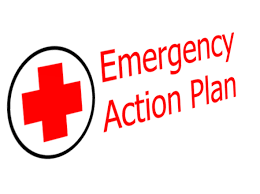Blog
Emergency Action Plans are critical for your workplace
by Paul Kazlauskas

A workplace emergency is any unforeseen situation that threatens your employees, customers, or the public; disrupts or shuts down your operations; or causes physical or environmental damage. A wide variety of emergencies, both man-made and natural, may require a workplace to be evacuated. These emergencies include …
- Floods, Tornados, or Hurricanes
- Fires
- Toxic material releases, such as from chemical spills, biological accidents, or radiological accidents
- Explosions
- Civil disturbances
- Workplace violence resulting in bodily harm and trauma.
Employers need to be proactive about planning for the above situations and consider a detailed Emergency Action Plan because it is difficult to think logically when actually going through an emergency. An Emergency Action Plan (EAP) is a written document required by particular OSHA standards. The purpose of an Emergency Action Plan is to facilitate and organize employer and employee actions during workplace emergencies. The elements of the plan should include, but are not limited to:
- Evacuation procedures and workplace emergency escape route assignments
- Procedures to be followed by employees who remain to run critical plant operations before they evacuate
- Procedures to account for all employees after an emergency evacuation has been completed
- Rescue and medical duties
- Means of reporting fires and other workplace emergencies
- Names or job titles of persons who can be contacted for further information or explanation of duties under the plan
A disorganized evacuation can result in confusion, injury, and property damage. When developing your Emergency Action Plan, it is important to determine the following:
- Conditions under which an evacuation would be necessary
- Conditions under which it may be better to shelter-in-place
- A clear chain of command and designation of the person in your business authorized to order an evacuation or shutdown
- Specific evacuation procedures, including routes and exits
- Specific evacuation procedures for high-rise buildings
- Procedures for assisting visitors and employees to evacuate, particularly those with disabilities or who do not speak English
- Designation of what, if any, employees will remain after the evacuation alarm to shut down critical operations or perform other duties before evacuating
- A means of accounting for employees after an evacuation
Emergency Action Plans enhance your company’s ability to recover from financial losses, damages to equipment or products or business interruption. EAPs also bond management and employees by having them share responsibilities in the plan. Finally, the creation of Emergency Action Plans gives companies the opportunity to establish relationships with law enforcement leaders and firefighters. The effort to plan ahead of time carries a lot of benefits.
A thorough Emergency Action Plan includes knowing exactly who is in your building at all times, especially non-employees like visitors, vendors, contractors etc, so you can account for everyone. A good visitor management system that tracks when people come and go can help manage that information. Schedule a free demo of eVisitor Software for visitor management.
Schedule a Demo of eVisitor Software
Posted on 7/24/2023



 Paul Kazlauskas
Paul Kazlauskas
 Andrew Jones
Andrew Jones